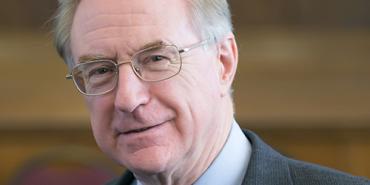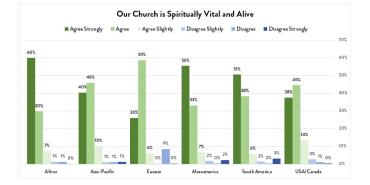Reaping Susanna's Legacy: Holiness and Pentecostal Movement
The Holiness and Pentecostal movements both appealed to America’s plain folk. They sprang from common soil and kinship. However, they embraced divergent views about the primary nature of the Holy Spirit’s work.
Early Nazarenes were rooted firmly in Wesleyan-holiness theology, so they rejected many of the emphases of early twentieth-century Pentecostalism. They did so first of all because the Pentecostal movement divorced the baptism of the Holy Spirit from entire sanctification, and second, emerging Pentecostalism focused on the gifts of the Spirit, rather than the fruits of the Spirit.
Nazarenes felt the chief orientation of entire sanctification was around the fruits of the Spirt: love, joy, peace, patience, kindness, goodness, faithfulness, gentleness, and self-control.
A third area of disagreement centered around the issue of speaking in unknown tongues: Pentecostals insisted that speaking in tongues was the “initial evidence” of Holy Spirit baptism.
As thorough-going Wesleyans, early Nazarenes believed in a genuine witness of God’s Spirit in the conversion of sinners and the entire sanctification of believers. In harmony with the Wesleyan tradition, Nazarenes held that the work of the Holy Spirit was verified through a two-fold witness: the “inner witness” and the “outer witness.” The inner witness describes a quiet but sure confidence in God’s saving and sanctifying grace. The Holy Spirit “bears witness to our spirit.”
The outer witness is neither tongues, nor emotion, nor any type of physical manifestation. It is the Christian life—a life lived in such a manner that its integrity and consistency proclaims a clear and definite witness to others of God’s grace in our lives. We could say that the outer witness is “authentic Christianity.” We might even say that the outer witness is like “a third sacrament”—an outward sign of a true and inward grace.
Bresee’s Wesleyan Vision
Phineas Bresee stated: “The Church of the Nazarene has set its face toward the northern star of perfect love and will not swerve to the right or to the left.”1
The emphasis on the priority of perfect love, or holiness, was rooted in Bresee’s personal sense of calling to urban ministry and ministry to the poor, as well as the passion of some of his closest associates for multi-cultural ministry.2 The emphasis, as he once put it, was on the “salvation of souls and relief of the needy.”
The Wesleyan Holiness Movement of the nineteenth century did like to use the word “Pentecostal.” However, they used it as a synonym for “holiness.” This was rooted in the argument that the disciples of Jesus, who had heard his call and become his followers, were subsequently sanctified entirely on the day of Pentecost through the baptism of the Holy Spirit. “Pentecost,” “Spirit-baptism,” and entire sanctification were concepts bound together in the theology of the late nineteenth century Holiness Movement.
Early Nazarenes inherited this vocabulary and understanding. The Association of Pentecostal Churches of America, the Pentecostal Mission, and the Pentecostal Church of Scotland were three of the seven denominations that merged into the Pentecostal Church of the Nazarene by 1915.
A Distinct Group Emerges
A new religious movement arose at the dawn of the twentieth century. At first, it was called the Apostolic Faith, but over time it became more widely known as “the Pentecostal Movement.” This movement used the word “Pentecostal” in a manner that was foreign to the understanding of the Wesleyan holiness people and to the early Nazarenes. “Pentecostal” became the name of new groups who sprang from a similar soil as the Wesleyan holiness movement but differed in theology and goals.
Charles Parham was modern Pentecostalism’s founder. For two years, he was pastor of a Methodist church in the small community of Eudora, Kansas, but Parham chose not to pursue ordination. He professed a strong dislike for Methodist bishops and district superintendents and to that church’s system of ministerial accountability. He became a freelance evangelist, roaming eastern Kansas conducting revivals. He emphasized faith healing and Christ’s premillennial second coming. He established a faith home and Bible school in Topeka, Kansas.
In 1900, Parham asked his students to study the Book of Acts and identify any outward signs that could be interpreted as “the initial evidence” of the baptism of the Holy Spirit. The students decided that speaking in tongues qualified as such a sign, and Parham agreed. He urged them to seek this gift. On January 1, 1901, a woman spoke in tongues after a New Year’s Eve watchnight service. Parham and others also did so in coming days.
Some of Parham’s followers believed that they had been given a supernatural gift of speaking foreign languages. They thought that they would assume a significant role in the global evangelization, since this gift would allow them to roam the world and preach in languages they had not learned. The first missionaries to try this, though, realized that these languages were not known languages. When they realized they were not speaking human languages, they decided they must be speaking in angelic languages instead.
Parham’s Pentecostal Beliefs
The Apostolic Faith’s theology emphasized Christian conversion, entire sanctification as a second work of grace, and the baptism of the Holy Spirit as a third work of grace, with “the gift of tongues” as its “initial evidence.” Parham took his theology to the towns around Houston, Texas, where he opened another Bible school.
A black Holiness evangelist named William Seymour became a student of Parham’s. Parham chose not to challenge the mores of the Jim Crow South, so he allowed only white students into the classroom. Seymour had to sit alone in the hallway to hear Parham’s lectures. Ironically, the segregated Seymour became the next major figure in Pentecostal history.
Seymour went to Los Angeles in 1906 and opened an independent mission on the corner of Azusa Street, a short street of only one block. The revival that originated there became a significant event in Pentecostal history. Evangelists and others from around America came to Los Angeles, knelt at Seymour’s altar, and spoke in tongues.
Differences Emerge
Phineas Bresee’s first notice of the new Pentecostalism appeared in December 1906, in his lead editorial for that week’s Nazarene Messenger. He noted two “peculiarities” of the revivalists: “speaking in tongues” and phenomena such as “laying on of hands.” Bresee wrote: “The meetings attracted some attention, especially among that class of people who are always seeking something new. We made no mention of the matter in the Messenger, not deeming it of sufficient importance to demand attention.” Any good deriving from it, Bresee explained, was also being carried out by the other churches in the city, but “so far as it partook of fanaticism and was fostered by heretical teaching, we did not care to give it prominence of public discussion.”
Bresee went on to criticize the new “tongues movement.” He was critical of those “who will run after the hope of . . .marvelous things,” adding that it is “to their own further undoing.” He concluded: “People who have the precious, satisfactory experience of Christ revealed in the heart by the Holy Spirit, do not hanker after strange fire, nor run after every [supposed] gift . . . ”3
An associate of Bresee, Rev. I. G. Martin, also noted the Azusa Street phenomenon, writing: “When any set of persons, so over-stress any one of the gifts of the Spirit as to make it their central doctrine, as for instance divine healing or the gift of tongues, it will invariably prove disastrous.” By contrast, “the grace of perfect love abides. It never fails. . . . It will abide when the world is on fire, and will be your passport through the gates into the city.”4
An editorial entitled, “Fanaticism and Humbugs” dealt specifically with “the so-called Gift of Tongues [and] Divine Healings.” Bresee wrote: “As to Faith Healing institutions and specialists,” there are many people who are healed in answer to prayer, most commonly in their homes through the prayers of their family. But, he cautioned, “persons who make faith healing a business are to be avoided.”5
An Amicable Parting of Ways
In our day, some have mistakenly asserted that early Nazarenes were Pentecostals in today’s sense of that word. Further, they argue that the Nazarene church changed, because the founders died off quickly and the remaining Nazarenes grew “cold.” Some even argue that a striking evidence of this “cooling off” occurred when the church dropped “Pentecostal” from the church’s official name in 1919. These propositions are not true.
Bresee and Rev. J. O. McClurkan were the only two major founders who died early in Nazarene history.
The church’s other founders were very much alive and took an active role in denominational life up into the 1930s and even the 1940s.
Hiram F. Reynolds, elected general superintendent in 1907 at the First General Assembly, occupied that office until 1932. John Goodwin, an early superintendent of the Southern California District, was elected general superintendent in 1916 and continued in office until 1940. Other founders who led the church until at least the 1930s include C. B. Jernigan and George Sharpe. C. W. Ruth, Mary Lee Cagle, J. B. Chapman, and R. T. Williams, all active in the Second General Assembly at Pilot Point, Texas (1908), remained primary leaders of the church well into the 1940s.
Simply stated, early Nazarenes never shared the same primary emphases of the group that became today’s Pentecostals. After 1919, when the name “Pentecostal” was dropped from the Church of the Nazarene, there was no schism or split where one group (Nazarenes) gave birth to a second group (modern Pentecostals). Instead, the Church of the Nazarene dropped the name “Pentecostal,” because a distinct group emerged that took on the name “Pentecostal.”
The differences have always been there between these two groups; however, both have found ways to work together in terms of mission and the proclamation of the Gospel for over a century. Nazarenes and Pentecostals owe much to the Wesleyan tradition, even though their interpretations and emphases are quite distinct.
Stan Ingersol is a church historian and manager of the archives of the Church of the Nazarene.
1. Phineas Bresee, Nazarene Messenger (August 18, 1904): 7.
2. Maye McReynolds, a close associate of Bresee’s, initiated the Nazarene outreach to Hispanics in the Los Angeles area, and then led the expansion of this ministry along the border with Mexico as far east as Texas. Other Bresee associates initiated ministries to the Chinese and Japanese immigrants in California.
3. Phineas Bresee, “The Gift of Tongues,” Nazarene Messenger (Dec. 13, 1906): 6.
4. I. G. Martin, “Gift of Tongues,” Nazarene Messenger (Oct. 26, 1906): 3.
5. Phineas Bresee, “Fanaticism and Humbugs,” Nazarene Messenger (June 27, 1907): 6.
Holiness Today, September/October 2018
Please note: This article was originally published in 2018. All facts, figures, and titles were accurate to the best of our knowledge at that time but may have since changed.




